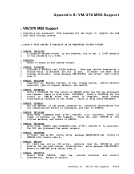Performance Guidelines General Information
The performance characteristics of an operatingsystem, when it is run
in a virtualmachine environment, are difficult to predict. This
unpredictability is a result of several factors:• The System/370 model used. • The total number of virtual machines executing. • The type of work being done by each virtual machine. • The speed, capacity, and number of the paging devices. • The amount of real storage available. • The degree of channel and control unit contention, as well as arm contention, affecting the paging device. • The type and number of Vft/370 performance options in use by one or more virtual machines. I • The degree of access to ftSS 3330V volume. Perforllance of any virtual machine may be improved up by the choice of hardware, operating system, and Vft/370 topics discussed in this section address:
tosome limit options. The
1. Theperformance options available in V!/370 to improve the
performance of a ,particular virtualmachine. 2. The system options and operational characteristics of operating systems running in virtual machines that will affect their
execution in the virtualmachine environment. The performance of a specific virtual machine may never equal that of
thesame operating system running standalone on the same System/370, but
the total throughput obtained in the virtualmachine environment may equal or better that obtained on a real machine. When executing in a virtual machine, any function that cannot be performed wholly by the hardware causes some degree of degradation in
the virtualmachine's performance. As the control program for the real machine, CP initially processes all real interrupts. A virtual machine operating system's instructions are always executed in 2roblem state.
Any privileged instruction issued by the virtualmachine causes a real
privileged instruction exception interruption. Theamount of work to be
done byCP to analyze and handle a virtual machine-initiated interrupt
depends upon the type andcomplexity of the interrupt.
Thesimulation effort required of CP may be trivial, as for a
supervisor call(SVC) interrupt (which is generally reflected back to
the virtualmachine), or may be more complex, as in the case of a Start I/O (SIO) interrupt, which initiates extensive CP processing. When planning for the virtual machine environment, consideration
should be given to thenumber and type of privileged instructions to be
executed by the virtual machines. Any reduction in thenumber of
privileged instructions issued by the virtualmachine's operating system will reduce the amount of extra work CP must do to support the machine. CP Introduction 1-25
The performance characteristics of an operating
in a virtual
unpredictability is a result of several factors:
to
1. The
performance of a ,particular virtual
execution in the virtual
the
the total throughput obtained in the virtual
the virtual
Any privileged instruction issued by the virtual
privileged instruction exception interruption. The
done by
depends upon the type and
The
supervisor call
the virtual
should be given to the
executed by the virtual machines. Any reduction in the
privileged instructions issued by the virtual








































































































































































































































































































































































































































































